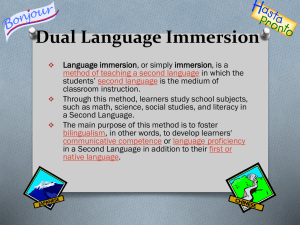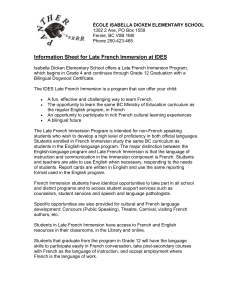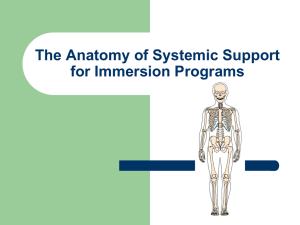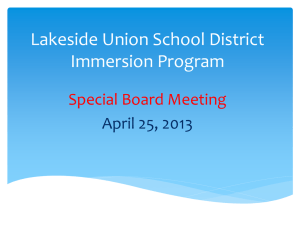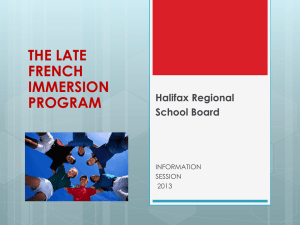The Lambert research blueprint
advertisement
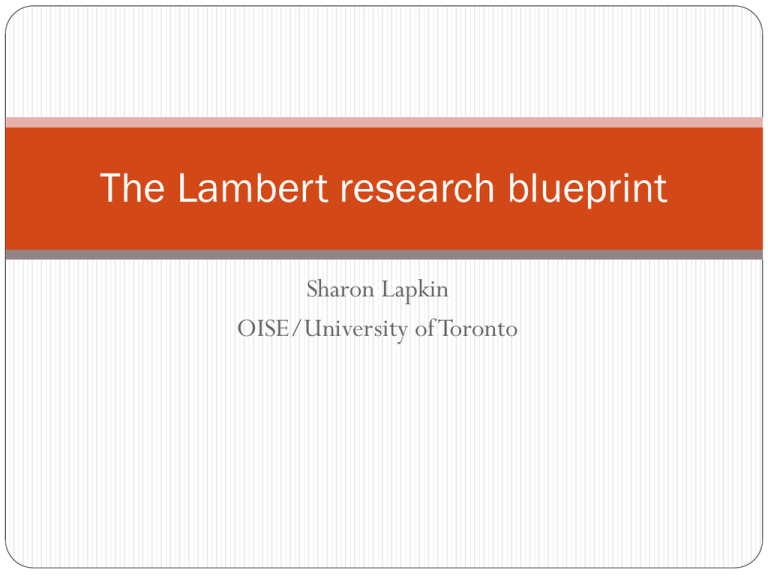
The Lambert research blueprint Sharon Lapkin OISE/University of Toronto Initial fears as expressed by principals While we favour bilingualism and the effective teaching of the French language from kindergarten to grade XI, we reject the so-called bilingual school which attempts to give equal or nearly equal importance to two languages as media of instruction. We are of the opinion that the average child cannot cope with two languages of instruction and to try to do so leads to insecurity, language interference, and academic retardation...” Key features of Lambert research design Comparison groups selected based on similarity of parental backgrounds and therefore socioeconomic status Non-verbal IQ measure was administered to ensure comparability of classes and to establish a baseline for future comparisons Two cohorts of immersion students (and comparison classes) followed for multiple years (longitudinal design) Research questions What effect does French immersion have on the students’ first language (English) skills? How well do French immersion students perform in school subjects such as mathematics? How well do French immersion students develop second language (French) skills? English language skills English language arts instruction was introduced for one hour a day starting in grade 2 Assessed at the end of grade 4 (1st cohort) and grade 3 (2nd cohort), immersion students were generally comparable to regular English program students on standardized tests of English and on tasks like story retelling These results were replicated in subsequent program evaluations in other jurisdictions across Canada English language arts (cont’) In less intensive French immersion programs (less French, more English), French immersion students performed as well as but not better than regular English program students (based on standardized tests of English achievement) EQAO results from Ontario on curriculum-based tests show that immersion students perform very well English language skills (cont’) Original research question was adapted What is What is the nature of the benefits that accrue to immersion students in the area of first language (English) skills? WHY? 1. Early immersion students reach a threshold level of proficiency in French, triggering a positive impact on first language (English) skills (Cummins, 1979) 2. Early French immersion students are “linguistic detectives” as a result of the ‘additive’ nature of their bilingualism (Lambert and Tucker, 1972) Achievement in mathematics Both of the St. Lambert cohorts performed as well as their respective comparison groups in math in grades 3 and 4, suggesting the knowledge was transferring from the target language (French) to the first language (English) “as [immersion students] develop high levels of L2 skills, their fluent access to two languages can give rise to enhancement both of L2 skills and other aspects of cognitive functioning” (Cummins, 1979) These findings were consistent with those of the EQAO testing in Ontario French language skills Lambert and Tucker found that the performance of the lead cohort at grade 4 was comparable to that of francophone peers in listening comprehension Their achievement scores placed them at or above the scores of half the francophone comparison class French vocabulary knowledge was somewhat (but not significantly) below that of francophone peers French speaking ability not as advanced as that of francophone comparison group French language skills (cont’) In an Ontario study of grade 9 French immersion students writing a test designed for franco-Ontarian students, immersion students performed better than the comparison group in reading and less well in writing On Public Service Commission tests, based on a sample from Edmonton, most grade 12 immersion students would be qualified for employment in the public service Lambert’s contribution Without the Lambert blueprint, we would not have French immersion programs today The Lambert legacy includes hundreds of research projects focusing on immersion education over the last 40 years or so
